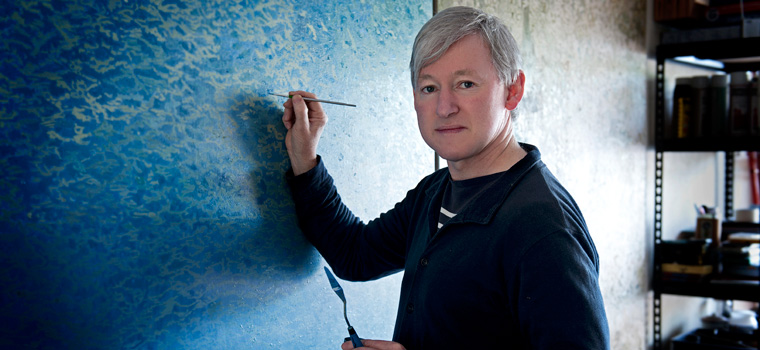
gregory pryor
The Yilgarn Lacunae
"In this new body of work, I am looking to compress some of the space and the immensity so often associated with landscape painting in Australia into a series of small devotional paintings. In renaissance devotional works (the early renaissance in particular), paintings were undertaken for private devotional uses, commissioned by wealthy patrons. These paintings needed to operate as a small, intimate conduit and medium of transportation to a much larger realm – the immensity of the Christian faith and the complex structure of heaven and earth, mediated through the Holy Spirit. Small biblical paintings, often of the Virgin Mary, the crucifixion or other portraits of martyred saints and biblical narratives were exclusively representational and in their tangible reality were seen to give devotees something recognizable (and earthly) to allow transportation to the intangible or transcendental reality that was at the heart of their faith.
My small paintings will be less representational, and will not be hierarchical or embedded with the linear narrative so present in the history of Christian painting. They aim however, to transport the viewer to a much larger space that for many, remains distant, unrecognised and little understood. The subject matter is derived from investigations into isolated landscapes of Western Australia – many of which are landscape fragments or remnants. These works are meditations upon the residues of country. They are consciously condensed into a crowded pictorial space and the hope is that these works create some sort of rebound in the viewer, allowing them to reimagine a completed or untouched landscape; a complex operating system tended to by the aboriginal custodians who recognise it as theirs.
So these little tableaux are addressing ideas of restoration, repatriation and repair. They also by necessity, need to acknowledge what has been lost and how this came to be, so they can be read as annals of destruction, templates of fracture and harrowing memorials to loss and emptiness."
Gregory Pryor April 7 2016
Biography
Since moving to Perth, from Melbourne in 2003, Gregory Pryor has been exploring the complexity and volatility of the West Australian landscape. His investigations started with large scale botanical projects which drew attention to the huge numbers of species found in this bio-diversity hot-spot, whilst simultaneously alerting us to it's threatened status. His focus then shifted back in time, to painterly reinterpretations of early West Australian colonial works. This series was followed by Lacunae in 2014; comprised of exquisite watercolours of abstracted West Australian bushlands. His current work is evolving into extraordinary and unique interpretations of the land that verge on abstraction, yet retain an authentic experience of the West Australian landscape.
Residencies and research play an important role in Pryor's artistic output. It was after a residency in Perth in 2002, where he was seduced by the abundant spring wildflowers in the Darling Ranges, that he decided to move to Western Australia. In 2007 he undertook a significant residency at the Taipei Artist Village, where he produced the monumental Black Noise (Ghost of Tongcao); a bi-lingual visual diary with hundreds of pages about his experiences, dreams and observations, during his stay in Taiwan. This impressive body of work was selected for the 2008 Adelaide Biennale at the Art Gallery of South Australia. Pryor has continued his association with Taiwan, participating in exhibitions, projects and regular visits.
Pryor continues to draw on his academic research and wealth of art history knowledge in his new work, a series of seventeen oil paintings. The starting point for his new series is Cesare Brandi's Theory of Restoration that was developed to deal with the overwhelming amount of damage to artworks in Italy caused by the Second World War. Brandi developed the technique of 'tratteggio', a visual system of abstracted lines that gives form to missing parts in paintings and frescoes, but does not strive to reproduce the missing material. Pryor wants to apply aspects of Brandi's theory not to previously existing artworks, but to incorporate them into new painterly interpretations of the landscape itself, and specifically, to the landscapes of Western Australia. In this way he acknowledges the missing and damaged parts of our landscape caused by land clearing and degradation, farming and urban development.
Gregory Pryor studied at RMIT University Melbourne, graduating in 1980. He has taught painting and drawing at the Victorian College of the Arts, Royal Melbourne Institute of Technology, Ballarat University, Monash University and the Latrobe Street School of Art and Design in Melbourne. He has been a lecturer in visual arts at Edith Cowan University since arriving in Perth in 2003 where he is now Head of Painting. With a strong basis in painting, Pryor's visual arts practice has evolved into many different areas, including drawing, video, performance and object based work. Pryor has exhibited extensively throughout Australia and overseas, and his academic writing includes numerous essays for catalogues and art publications.
Pryor has a distinguished international career as a painter with works represented in important collections including the National Gallery of Australia, National Gallery of Victoria, Queensland Art Gallery, Art Gallery of Western Australia, Murdoch University Art Collection, City of Perth Art Collection, Lawrence Wilson Art Gallery at the University of Western Australia, Edith Cowan University and the Wesfarmers Collections. Pryor received a highly sought after Creative Arts Development Fellowship from the West Australian Department of Culture and the Arts WA in 2015.
- TURNER GALLERIES | showcasing contemporary art
at 470 WILLIAM STREET NORTHBRIDGE WESTERN AUSTRALIA 6003 - TURNER GALLERIES HAS NOW CLOSED.
This website is an archived record of the exhibitions and artwork shown at the gallery. - Turner Galleries acknowledges the Whadjuk Nyoongar people as the Traditional Owners of the lands and waters where Turner Galleries is situated, and pay our respect to Elders past, present and emerging.
- Website © 2000-2024 TURNER GALLERIES. All images are © the artists and are not to be used without permission.
- This is a millapede project.